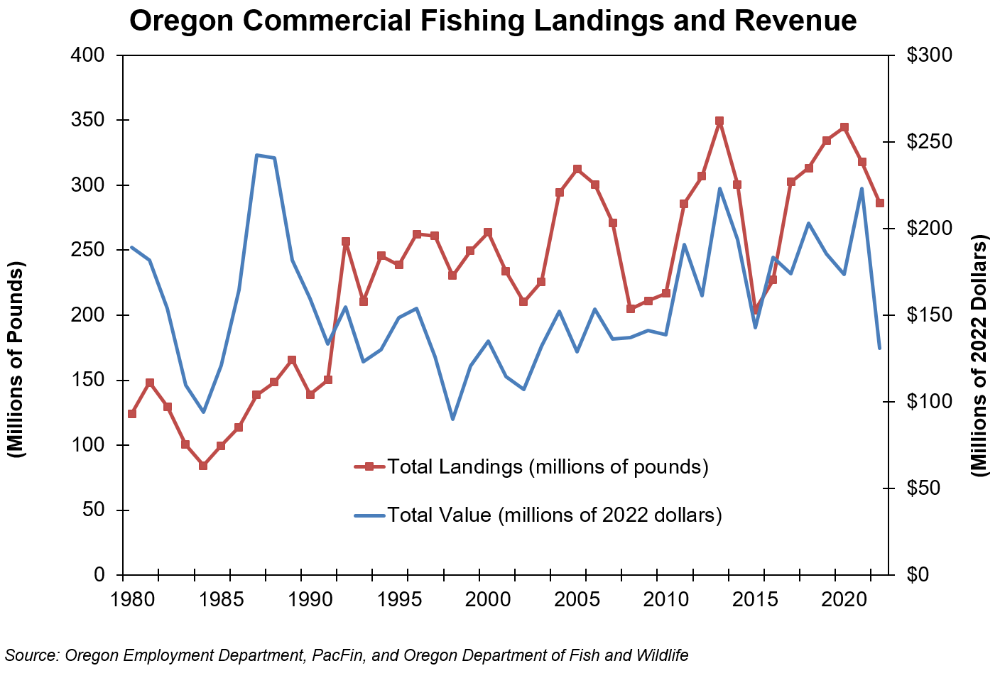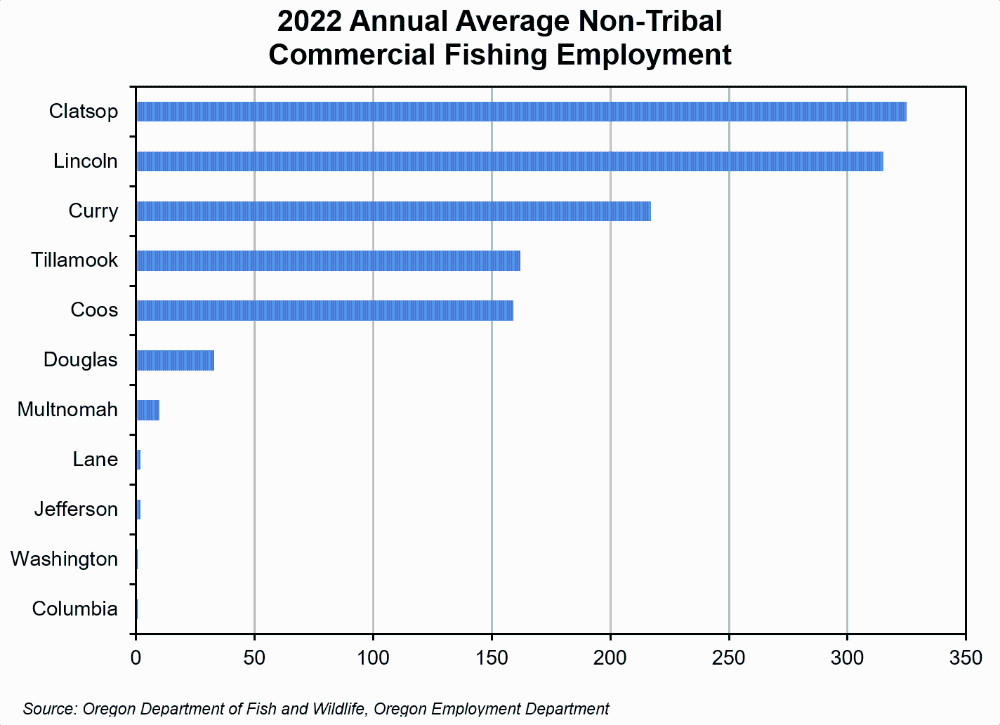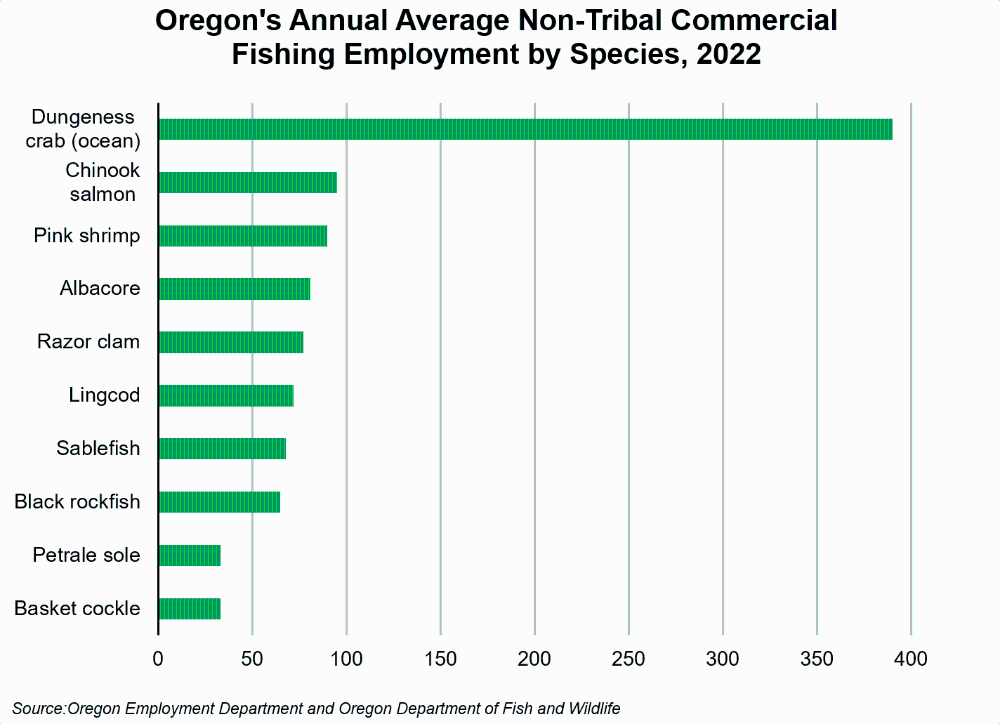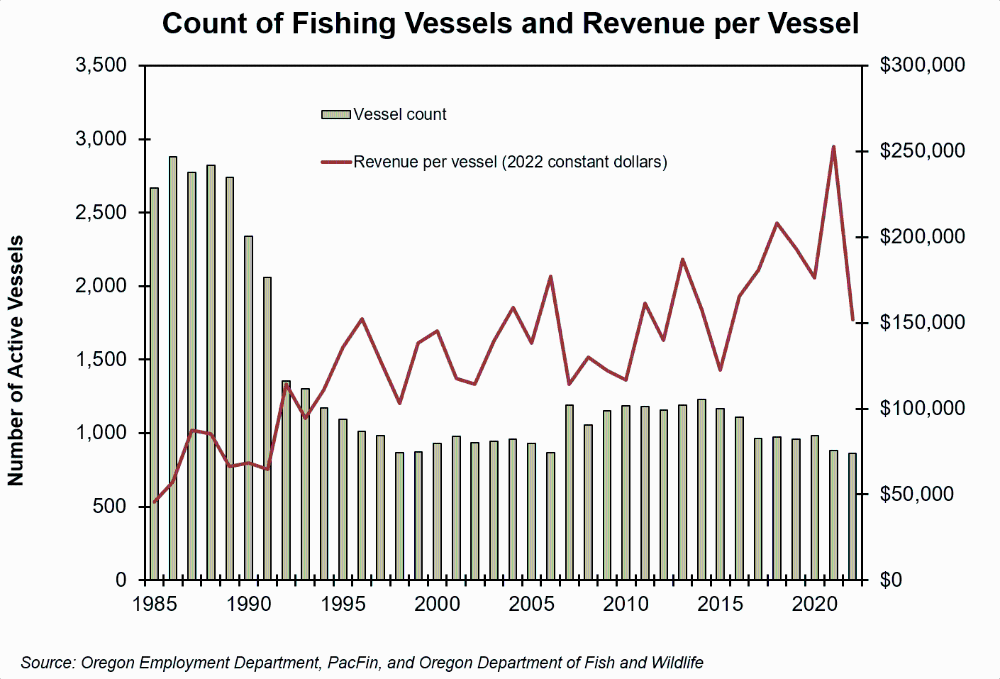Oregon’s Commercial Fishing in 2022
April 7, 2023Oregon’s commercial fishing industry revenues dropped 41% to $231 million in 2022, mostly due to a delayed Dungeness crab harvest. It was the worst crab year since 2015. Total commercial fishing harvests averaged about $192 million (2022 dollars) over the previous five years. But after a bumper year in 2021, the 2022-2023 Dungeness crab season failed to start at all in December 2022. Since most crab are landed early in the season, this meant that the 2022 calendar year logged an unusually small harvest. A smaller pink shrimp harvest also contributed to the decline in 2022. Overall the revenue from fishing fell by $92.3 million in 2022, and the volume of harvests decreased by 31 million pounds.
Individual fisheries
Crab harvests in 2022 fell 80% to 4.9 million pounds, the worst harvest since 2.3 million pounds were landed in 2015. The crab season in Oregon didn’t fully open until February 1, 2023. Higher prices helped offset some of the revenue drop; the average price over all of 2022 was $6.38 per pound. The crab harvest was worth $31 million in 2022, about 74% less than the year before. Dungeness crab is usually Oregon’s most valuable fishery, and it barely managed to retain that status in 2022.

Salmon landings rose 21% in 2022, to nearly 2.2 million pounds. This was more than the past few years but still well below the average of the 2000s and 2010s. The average price dipped only slightly to $3.55 per pound. As a result, the total landed value rose 17% to $7.7 million. This made 2022 better than the previous five years, but the commercial salmon fishery faces significant restrictions and possible closure in 2023.
The pink shrimp harvest was 41 million pounds in 2022, a decrease of 12% from 2021, and close to the average of recent years. Unfortunately, shrimp prices fell slightly from 50 cents to 46 cents per pound in 2022. The total value landed decreased 20% to $18.8 million. This was just a little below the average of recent years. Oregon pink shrimp was certified as a sustainable fishery by the Marine Stewardship Council in 2007 and reassessed as sustainable in 2011.
The amount of whiting landed fell for the third year in a row, dropping 7% in 2022 to 170 million pounds. Whiting accounted for 59% by weight of all wild seafood landed in Oregon, but it has a low value. The price did increase by two cents to 11 cents per pound in 2022, so the total landed value for this fishery rose 8% to $18.9 million. Much of Oregon’s whiting is made into surimi for use in making artificial crab meat.
The value of groundfish landed increased 34% in 2022 to $30.2 million. The landed value had been dropping for a few years so 2021 and 2022 represented a small recovery. In 2022 the fishery was finally above its average of the 2010s. The amount landed increased by 11% to 50 million pounds, and the average price rose 10 cents per pound to 60 cents.
The albacore tuna harvest rose 95% in 2022 after a significant slump in 2021. The harvest returned a level that was typical of most recent years. Fortunately, the price also increased 11% to $2.29 per pound. Accordingly, the total value landed rose by 117% in 2022 to $14.3 million. This was the highest level since 2013. Albacore has become an important fishery in recent years, especially for smaller boats that depended on salmon.
Smaller fisheries also had some changes. The razor clam harvests jumped nearly tenfold to $1.2 million, the highest value since at least 1988. The harvest of Pacific mackerel increased from nearly nothing to about $67,000. This fishery fluctuates dramatically. The harvest of another fluctuating fishery, Eulachon smelt, nearly tripled in 2022 to $33,000. The market squid harvest dropped 26% to $3.4 million. The squid fishery grew from nothing in 2017 to $6 million in 2020. This is the second year of decline for this emerging fishery. Finally, a small blue marlin was landed in 2022. They are typically found in tropical and subtropical waters.
Employment
There were an estimated 1,227 commercial fishers (excluding tribal fishing) in Oregon on an annual average basis in 2022. This was the same as the previous year, and quite similar to the 1,199 commercial fishers estimated in 2020. The delay in the 2022-2023 crab season probably helped suppress employment. It had been about 100 to 200 higher before the COVID-19 pandemic.

Estimating employment in fishing is more difficult than measuring the harvests. Legislation in 1999 allowed most fishers to be exempt from unemployment insurance coverage – the primary source of employment data. The Oregon Employment Department now estimates the number of fishers based on a combination of survey data and the number commercial fish landings made in Oregon. This method was new for 2014 and resulted in a lower employment estimate than before. Oregon vessels or crews making landings outside of Oregon are not included in these estimates of employment in Oregon.
The estimated number of fishers in 2022 varied from a high of 1,567 in March to a low of 391 in December. Fishing employment often peaks in the summer, but the past couple years have shown a subdued summer season and a peak in the spring. Five coastal counties – Clatsop, Coos, Curry, Lincoln, and Tillamook – had 96% of the total employment, based on where landings occur. Perhaps even more surprising is that non-coastal Jefferson County had any commercial fishing employment. These jobs are sometimes based on crayfish harvests.

The most important fisheries for direct employment are crab, salmon, and pink shrimp. The estimates of employment by species represent the minimum number of people in that fishery on an annual basis. Landings are counted by only the most valuable species landed that trip. Oregon’s largest fishery by volume, Pacific whiting, was the 12th largest by direct employment. But whiting is very important for the processing industry and its employment. Commercial fishers harvested about 100 different species in 2022.
Revenue
The number of fishing vessels has certainly declined from historic highs. It has become somewhat more stable since the late 1990s, but still fluctuates by a couple hundred. The past six years have been a period of declining numbers of vessels. Fishing began generating more revenue per boat after the turn of the century, albeit with plenty of fluctuations. There were 861 vessels with at least one landing in 2022, down from 882 in 2021. They averaged about $152,000 each in landed value in Oregon in 2022, down sharply by 40% from the previous year. Each vessel supported about 1.4 workers on an annual average basis; many vessels have landings only part of the year.

In addition to direct employment, commercial fishing provides the resource for seafood processors. Complete data on processors for 2022 are not available yet, but employment through the third quarter of 2022 averaged about the same as 2021. There were 1,086 jobs in the industry in 2021. Records show that there were 34 seafood processors in Oregon that had employees in 2021; it looks like Oregon added one more processor in 2022. Some processors also use temporary help firms to round out their staffing, but these employees are counted in the business services industry. The processing industry paid more than $49 million in wages in 2021, which clearly shows the benefit of adding value to raw natural products.